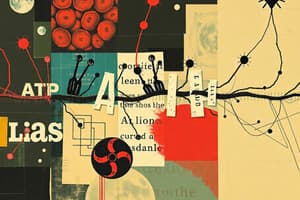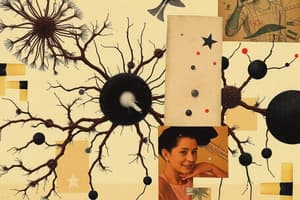Podcast
Questions and Answers
What is the main difference between catabolism and anabolism?
What is the main difference between catabolism and anabolism?
- Catabolism generates precursors for biosynthesis; anabolism synthesizes complex molecules. (correct)
- Catabolism provides building blocks for biosynthesis; anabolism uses them for energy.
- Catabolism focuses on the synthesis of complex molecules; anabolism breaks them down.
- Catabolism requires energy; anabolism releases energy.
Which form of energy is primarily used by cells to carry out work?
Which form of energy is primarily used by cells to carry out work?
- Adenosine triphosphate (ATP) (correct)
- Uridine triphosphate (UTP)
- Guanosine triphosphate (GTP)
- Cytosine triphosphate (CTP)
What does a negative change in free energy (ΔG) indicate about a chemical reaction?
What does a negative change in free energy (ΔG) indicate about a chemical reaction?
- The reaction requires energy input to proceed.
- The reaction is non-spontaneous.
- The reaction occurs spontaneously. (correct)
- Products have more free energy than reactants.
According to the second law of thermodynamics, what happens during energy conversions?
According to the second law of thermodynamics, what happens during energy conversions?
Which of the following best describes entropy?
Which of the following best describes entropy?
What role do fueling reactions play in metabolism?
What role do fueling reactions play in metabolism?
What type of work involves the synthesis of complex molecules within an organism?
What type of work involves the synthesis of complex molecules within an organism?
Which of the following correctly describes energy in the context of work?
Which of the following correctly describes energy in the context of work?
What characterizes an exergonic reaction?
What characterizes an exergonic reaction?
Which statement about chemical equilibrium is true?
Which statement about chemical equilibrium is true?
What is indicated by a more negative standard reduction potential (E0)?
What is indicated by a more negative standard reduction potential (E0)?
What occurs in oxidation-reduction (redox) reactions?
What occurs in oxidation-reduction (redox) reactions?
What distinguishes competitive inhibitors from noncompetitive inhibitors?
What distinguishes competitive inhibitors from noncompetitive inhibitors?
What is a key feature of metabolic channeling?
What is a key feature of metabolic channeling?
Which mechanism involves the reversible addition or removal of a chemical group to control enzyme activity?
Which mechanism involves the reversible addition or removal of a chemical group to control enzyme activity?
What is the function of ribozymes?
What is the function of ribozymes?
What is the relationship between substrate concentration and enzyme activity?
What is the relationship between substrate concentration and enzyme activity?
How does temperature affect enzyme activity?
How does temperature affect enzyme activity?
What is feedback inhibition?
What is feedback inhibition?
What defines a holoenzyme?
What defines a holoenzyme?
Which of the following describes an enzyme's active site?
Which of the following describes an enzyme's active site?
Which type of electron carrier is known as ubiquinone?
Which type of electron carrier is known as ubiquinone?
What is the primary role of catabolism in cellular metabolism?
What is the primary role of catabolism in cellular metabolism?
Which type of work does NOT involve movement or changes in physical position?
Which type of work does NOT involve movement or changes in physical position?
Which statement correctly reflects the first law of thermodynamics?
Which statement correctly reflects the first law of thermodynamics?
What role do free energy ($ riangle G$) changes play in a chemical reaction?
What role do free energy ($ riangle G$) changes play in a chemical reaction?
Which molecule serves as the primary energy currency in cells?
Which molecule serves as the primary energy currency in cells?
In the context of entropy, how is free energy characterized?
In the context of entropy, how is free energy characterized?
Which of the following statements best describes transport work?
Which of the following statements best describes transport work?
What happens to energy when a reaction occurs according to the second law of thermodynamics?
What happens to energy when a reaction occurs according to the second law of thermodynamics?
Which statement correctly describes the equilibrium constant (Keq)?
Which statement correctly describes the equilibrium constant (Keq)?
What is the role of a reducing agent in a redox reaction?
What is the role of a reducing agent in a redox reaction?
How do competitive inhibitors affect enzyme activity?
How do competitive inhibitors affect enzyme activity?
Which factor can lead to enzyme denaturation?
Which factor can lead to enzyme denaturation?
What is the role of substrates in enzyme reactions?
What is the role of substrates in enzyme reactions?
What is true about ribozymes?
What is true about ribozymes?
Which component of an enzyme is referred to as a cofactor?
Which component of an enzyme is referred to as a cofactor?
What mechanism regulates metabolic processes by differential localization of enzymes?
What mechanism regulates metabolic processes by differential localization of enzymes?
What is an example of allosteric regulation of enzyme activity?
What is an example of allosteric regulation of enzyme activity?
What does feedback inhibition achieve in metabolic pathways?
What does feedback inhibition achieve in metabolic pathways?
Which aspect of enzymes affects their specificity?
Which aspect of enzymes affects their specificity?
Which statement about coenzyme Q (CoQ) is accurate?
Which statement about coenzyme Q (CoQ) is accurate?
What defines the term holoenzyme?
What defines the term holoenzyme?
Flashcards
Metabolism
Metabolism
The sum of all chemical reactions in a cell, divided into catabolism and anabolism.
Catabolism
Catabolism
Breaking down complex molecules into simpler ones, releasing energy.
Anabolism
Anabolism
Building complex molecules from simpler ones, requiring energy.
ATP
ATP
Signup and view all the flashcards
Free Energy (ΔG)
Free Energy (ΔG)
Signup and view all the flashcards
First Law of Thermodynamics
First Law of Thermodynamics
Signup and view all the flashcards
Second Law of Thermodynamics
Second Law of Thermodynamics
Signup and view all the flashcards
Entropy
Entropy
Signup and view all the flashcards
Exergonic Reaction
Exergonic Reaction
Signup and view all the flashcards
Endergonic Reaction
Endergonic Reaction
Signup and view all the flashcards
Reversible Reaction
Reversible Reaction
Signup and view all the flashcards
Chemical Equilibrium
Chemical Equilibrium
Signup and view all the flashcards
Equilibrium Constant (Keq)
Equilibrium Constant (Keq)
Signup and view all the flashcards
Standard Reduction Potential (E0)
Standard Reduction Potential (E0)
Signup and view all the flashcards
Oxidation-Reduction (Redox) Reaction
Oxidation-Reduction (Redox) Reaction
Signup and view all the flashcards
Electron Carriers
Electron Carriers
Signup and view all the flashcards
Enzyme
Enzyme
Signup and view all the flashcards
Substrate
Substrate
Signup and view all the flashcards
Activation Energy
Activation Energy
Signup and view all the flashcards
Competitive Inhibitor
Competitive Inhibitor
Signup and view all the flashcards
Noncompetitive Inhibitor
Noncompetitive Inhibitor
Signup and view all the flashcards
Chemical work
Chemical work
Signup and view all the flashcards
Transport work
Transport work
Signup and view all the flashcards
Mechanical work
Mechanical work
Signup and view all the flashcards
Equilibrium
Equilibrium
Signup and view all the flashcards
Electron Donor
Electron Donor
Signup and view all the flashcards
Electron Acceptor
Electron Acceptor
Signup and view all the flashcards
Ribozyme
Ribozyme
Signup and view all the flashcards
Study Notes
Microbial Metabolism
- Metabolism encompasses all chemical reactions within a cell.
- It's divided into two parts:
- Catabolism: Breaking down reactions.
- Anabolism: Building up reactions.
Catabolism
- Fueling reactions: Provide energy to the cell.
- Energy-conserving reactions: Store energy in easily usable forms.
- Provides a ready source or reducing power (electrons).
- Generates precursors for biosynthesis.
Anabolism
- Synthesis of complex organic molecules from simpler ones.
- Requires energy from catabolic reactions.
Major Nutritional Types of Microorganisms
- Photolithotrophic autotrophs (Photolithoautotrophy): Use light energy to synthesize organic compounds from inorganic sources like carbon dioxide. Examples include algae and some bacteria.
- Photoorganotrophic heterotrophs (Photoorganoheterotrophy): Use light energy, but require organic molecules as a source of carbon. Examples include purple nonsulfur bacteria and green nonsulfur bacteria.
- Chemolithotrophic autotrophs (Chemolithoautotrophy): Obtain energy through inorganic chemical reactions and use inorganic carbon as a carbon source. Examples include sulfur-oxidizing, hydrogen, and nitrifying bacteria.
- Chemoorganotrophic heterotrophs (Chemoorganoheterotrophy): Obtain energy by breaking down organic molecules and use organic carbon. Examples include protozoa, fungi, and most nonphotosynthetic bacteria (including pathogens).
Types of Work Carried Out by Organisms
- Energy: The capacity to cause changes or do work.
- Chemical work: Synthesis of complex molecules.
- Transport work: Uptake of nutrients, elimination of wastes, and ion balances.
- Mechanical work: Movement of organisms or cells and movement of internal structures.
Energy Currency of Cells
- ATP: Used to transfer energy from the cell's energy-conserving systems to the systems that carry out cellular work.
- Other nucleotides (GTP, UTP, CTP) also involved in energy transfer.
The Cell's Energy Cycle
- ATP is generated through aerobic respiration, anaerobic respiration, fermentation, and photosynthesis.
- The generated ATP powers chemical, transport, and mechanical work within the cell.
Laws of Thermodynamics
- First Law: Energy cannot be created or destroyed, only transformed. Chemical energy in food converts to chemical energy in ATP and then to mechanical energy.
- Second Law: Energy transformations result in a loss of usable energy. 25% of gasoline's chemical energy is useful, rest is lost as heat, similar inefficiencies exist with ATP use in muscle.
Entropy
- Measure of randomness or disorder.
- Organized forms of energy have low entropy.
- Unorganized forms have high entropy.
- Energy conversions result in heat increasing the universe's entropy.
Free Energy
- Free energy (G): The amount of energy released or used in a chemical reaction.
- ΔG: Change in free energy.
- ΔG < 0 (negative): Reaction favors products (spontaneous reaction).
- ΔG > 0 (positive): Reaction favors reactants and requires energy input.
Types of Reactions
- Exergonic reactions: Release energy (ΔG < 0).
- Endergonic reactions: Absorb energy (ΔG > 0).
- Reversible reactions: Free energy difference near zero; reaction at equilibrium (A ⇌ B).
Oxidation-Reduction (Redox) Reactions
- Transfer of electrons from a donor to an acceptor.
- Reducing agent (reductant): Donates electrons.
- Oxidizing agent (oxidant): Accepts electrons.
- Release energy important to the cell.
Electron Carriers
- Act as temporary storage for the transferred electrons during reactions.
- Examples include NAD, NADP, FAD, FMN, and Coenzyme Q (CoQ/Ubiquinone).
Biochemical Pathways
- Enzymes can be linked to form linear, cyclic, or branching pathways.
- Pathways overlap and feed into each other, forming complex networks.
- Dynamic pathways used to monitor changes in metabolite concentrations.
Enzymes
- Protein catalysts that speed up reactions without being consumed.
- Highly specific for the reactions catalyzed and molecules they act on.
- Substrates are reacting molecules that bind to enzymes.
- Products are the substances formed.
Enzyme Structure and Classification
- Some enzymes are made up of solely polypeptides.
- Others consist of polypeptides and non-protein components.
- Apoenzyme: Protein component of an enzyme.
- Cofactor: Non-protein component (prosthetic group—firmly attached versus coenzyme—loosely attached).
- Holoenzyme: Entire active enzyme with both apoenzyme and cofactor.
- Enzymes classified according to the reactions they catalyze. (e.g., Oxidoreductases, Transferases, Hydrolases, Lyases, Isomerases, Ligases)
The Mechanism of Enzyme Reactions
- Enzyme-substrate complex forms.
- Transition-state complex resembles both substrates and products.
Activation Energy
- Energy needed to start a reaction, lower by enzymes.
How Enzymes Lower Activation Energy
- Increase substrate concentrations at the active site.
- Orient substrates properly for complex formation.
Interaction of Enzymes and Substrates
- Lock and key model: Enzymes and substrates have complementary shapes that fit together.
- Induced fit model: Active site changes shape to accommodate the substrate, creating a tighter fit after binding.
Effect of Substrate Concentration
- Reaction rate increases with increasing substrate concentration until all enzyme molecules are saturated.
- Beyond this point, adding more substrate will not increase reaction rate.
Effect of pH and Temperature
- Each enzyme has a specific pH and temperature optimum for highest activity.
- Denaturation: Loss of enzyme structure and activity when these conditions deviate significantly from optimal.
Enzyme Inhibition
- Competitive inhibition: Inhibitor directly competes with substrate for the active site.
- Noncompetitive inhibition: Inhibitor binds to a site other than the active site, changing the enzyme's shape and decreasing activity
Ribozymes
- RNA molecules that act as catalysts.
- Examples include self-splicing RNA and enzymes involved in replication and other reactions.
Regulation of Metabolism
- Essential for maintaining energy and material balance despite environmental changes.
- Mechanisms include metabolic channeling (controlling localization of enzymes and substrates), enzyme regulation (enzyme synthesis/degradation, and post-translation enzyme modifications), and feedback inhibition (product of pathway stops the reaction)
Metabolic Channeling
- Differential localization of enzymes and metabolites in different compartments of the cell.
- Can create marked variations in metabolite concentrations.
Post-Translational Regulation
- Reversible addition or removal of chemical groups (e.g., phosphorylation) alters enzyme activity.
Allosteric Regulation
- Effector molecules bind to regulatory sites, changing enzyme shape and thus activity.
Feedback Inhibition
- Product of a pathway inhibits earlier enzymes in the same pathway.
- Helps regulate overall pathway activity.
Isoenzymes
- Different enzymes catalyzing the same reaction.
Studying That Suits You
Use AI to generate personalized quizzes and flashcards to suit your learning preferences.




